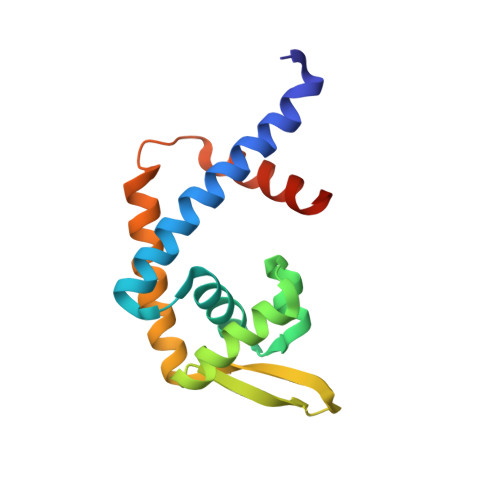Structural analysis of BldR from Sulfolobus solfataricus provides insights into the molecular basis of transcriptional activation in archaea by MarR family proteins.
Di Fiore, A., Fiorentino, G., Vitale, R.M., Ronca, R., Amodeo, P., Pedone, C., Bartolucci, S., De Simone, G.(2009) J Mol Biol 388: 559-569
- PubMed: 19298823
- DOI: https://doi.org/10.1016/j.jmb.2009.03.030
- Primary Citation of Related Structures:
3F3X - PubMed Abstract:
The multiple antibiotic resistance regulator (MarR) family constitutes a significant class of transcriptional regulators whose members control a variety of important biological functions such as regulation of response to environmental stress, control of virulence factor production, resistance to antimicrobial agents, and regulation of aromatic catabolic pathways. Although the majority of MarR family members have been characterized as transcriptional repressors, a few examples of transcriptional activators have also been reported. BldR is a newly identified member of this family that has been demonstrated to act as a transcriptional activator in stress response to aromatic compounds in the crenarchaeon Sulfolobus solfataricus. In this work, we report findings on the BldR X-ray crystal structure and present a molecular modeling study on the complex that this protein forms with its cognate DNA sequence, thus providing the first detailed description of the DNA-binding mechanism of an archaeal activator belonging to the MarR family. Two residues responsible for the high binding specificity of this transcriptional regulator were also identified. Our studies demonstrated that, in Archaea, the capability of MarR family members to act as activators or repressors is not related to a particular DNA-binding mechanism but rather could be due to the position of the binding site on the target DNA. Moreover, since genes encoding MarR proteins often control transcription of operons that encode for multisubstrate efflux pumps, our results also provided important insights for the identification of new tools to overcome the microorganism's multidrug resistance.
Organizational Affiliation:
Istituto di Biostrutture e Bioimmagini-CNR, via Mezzocannone 16, Naples, Italy.















